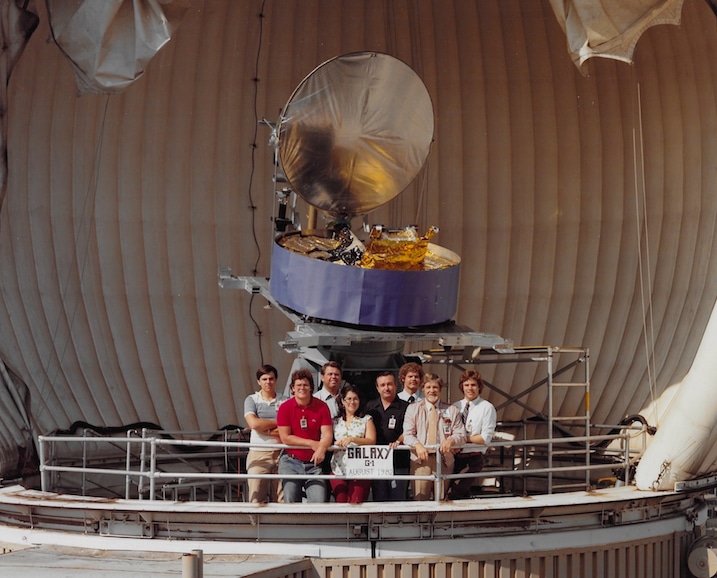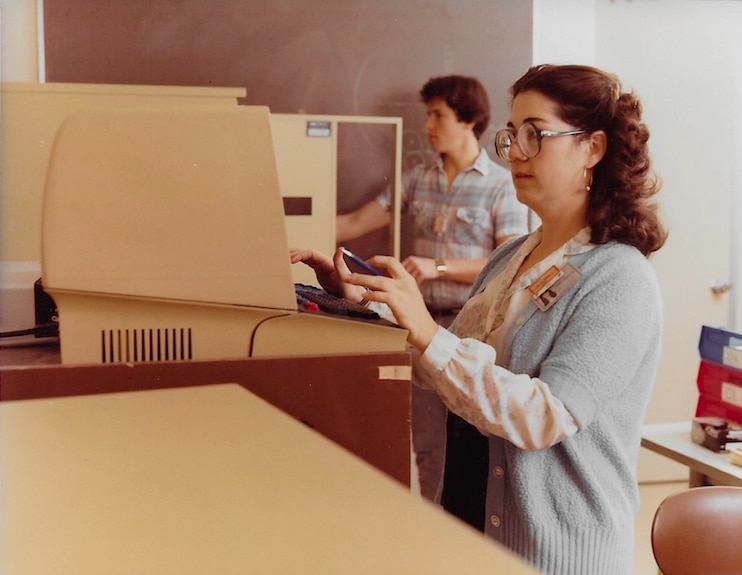
Maureen Meyer, fellow engineers, and technicians in front of the Galaxy G-1 Satellite on top of building S-12 at the Hughes Aircraft Co., El Segundo, California. The team build the antenna that went on the Galaxy G-1 Satellite. (1982.)
“There was a lot of resistance to having women in the engineering”
In 1980, Maureen K. Meyer was the first female engineer to be employed in the Antenna & Microwave Department within the Space and Communications Division at Hughes Aircraft (which was acquired by Boeing in 1997), a major American aerospace and defense contractor. During her time at Hughes Aircraft, she impacted the social and cultural environment of the male-dominated engineering industry by cultivating a more open working place for women in engineering. She encouraged her bosses to hire more women into aerospace engineering and by the time she left, the percentage had risen to 7 percent women among engineers at Hughes. She continues to affect the lives of young women through her teaching career and has inspired a number of her female students to become engineers and scientists, including her own daughter.
By Marirose Meyer
What did you do when you were an engineer, and what do you do now?
I started as a student engineer in 1980. I was hired as an intern in the antenna microwave department. I started in design, using computer software to help develop antenna communication systems that were designed for geosynchronous orbit, i.e., space satellite. At one point my boss, Frank Taormina, said, “If you become an engineer who can design and work on hardware, you’ll always have a job.” So I transitioned to testing the hardware: the antennas and the horn networks on the ranges.
When I graduated from California State University, Northridge (CSUN) with my engineering degree I was offered full-time employment with the Antenna & Microwave Department. For the next eight years, I worked on programs for AT&T, SBS, Japansat, Intelsat 6, Brazilsat, as well as classified military satellites. My tasks included designing the antenna system, supervising the building of the hardware and the final testing of the flight hardware. Ultimately I was made a Program Engineer, in charge of my first project Thaisat from start to finish.
Was that in college or after college?
I had already acquired a degree in Chemistry and then realized I couldn’t find a job in Southern California in the chemistry field, other than quality control jobs on production lines for soap and shampoos. I worked in biomedical research labs at UCLA and the Brentwood VA for a couple of years. I took a job at the SCAQMD (South Coast Air Quality Metropolitan District) because they had just opened jobs to women with technical degrees in their Field Inspections department. It was because of this job that I truly realized that I wanted to be an engineer. And so, after 17 months, I decided I’d go back to school. The program at CSUN required students to obtain an internship. Then I took engineering courses in mechanics, thermodynamics, circuits and antenna microwave engineering. After two years, I was hired as a full-time engineer with responsibilities in designing, developing, and building microwave antennas that were the payloads on satellites for communication. That was my favorite part, the actual building, assembly and testing of the antenna systems. It was so satisfying to build a network that worked just as you designed it to work. [Laughs.]
When you were going to school for your engineering degree, what was the most challenging for you?
Some of the challenging aspects were that engineering is different from other fields; it teaches you how to solve a problem. Not that chemistry doesn’t, but it was solving problems in a different way. It was challenging by the fact that I had to hold an internship while going to school at the same time. I ended up in a program that was organized for women who held college degrees, but wanted to go into the engineering field. Altogether, there were 66 of us. The program, entitled “Women in Engineering,” resulted from a grant written by professor Dr. Bonita J. Campbell at CSUN. Dr. Campbell’s intention for the program was to encourage women to enter the engineering field. Even though this was a program for women, some of the male professors had a bias. Our electrical circuits professor would tell our class that our problem was that we needed to spend more time studying. He went on to explain that when he was in college, his wife took care of all the household chores, the shopping, the cooking and the children, so that he could spend his time studying. And that was what we should do! As I looked around, I could see that a few of the older students, who were the sole breadwinner in their families, were barely holding in their emotions. So I raised my hand and explained to the professor that I agreed, if I had a wife to do my shopping and childcare, I too could spend all my time studying! This was the joke of our class – when we were stressed due to deadlines or tests – we would look at one another and sigh—“If only we had a wife!” We overcame that bias by supporting each other.
What do you do now?
I worked for 20 years as an engineer, and during that time I also got married and had children. I ended up homeschooling my children and found a job where I could teach online. So now, I teach all levels of high school math, algebra I, through calculus. When the need arises, I also teach chemistry and physics.
If you went back to the aerospace industry today, what would be different?
I’d probably see more female engineers. When I started at Hughes Aircraft, I was the only woman engineer in the 13-story building. The only other women were the secretaries and they were not that numerous either, usually one secretary for every 40 engineers.
Do you think the perspective on female engineers in the engineering industry has changed?
It’s changed. When I started, there was a lot of resistance to having women in the engineering field. It was something that men of the older generation just thought was not a field for women, too dangerous or too complicated. The first time I walked into the lab where they were testing microwave antennas, I saw all these risqué female pictures up on the wall, and thought, “My goodness, this is why my father didn’t want me to be an engineer.” There were comments like, “The only reason they hired you was because you’re a woman.”
I hung in there, I had seven brothers after all! I went to work, did my job the best I could. As a female engineer, you never made mistakes. You checked, double-checked, and triple-checked your work because some of the senior engineers were always looking to catch your mistakes. When other young women came into the field, I always introduced myself, let them know if they had any questions that they shouldn’t be afraid to ask me.
Why was there resistance?
It was always perceived as a man’s job. You had to take a lot of math, and that’s something women didn’t do. Chemistry required almost the same math and physics courses as engineering. Upon graduating from University of California, Los Angeles (UCLA) with a degree in Chemistry, I went to the counseling and career center. It was then that I found that most of the professional positions in chemistry were in New Jersey and Texas. When I realized I couldn’t be a chemist here in California, aerospace engineering seemed to be the next logical choice, because I already had a good majority of the math classes completed. My father was an aerospace engineer, and growing up hearing stories from my father about the industry truly ignited my passion for the field. I forgot about that passion until I decided to go back to school.

Maureen Meyer in the computer room designing microwave antennas, Hughes Aircraft Co. El Segundo, CA. (1982.)
Your father didn’t want you to become an engineer. Why was that?
When I first started college, I wanted to do engineering, but my father was very discouraging. I used to think, “Why is that?” I ended up picking chemistry because I enjoyed it and it was also the subject my father hated the most. I figured, if I picked the subject he didn’t know anything about, he’d think I was brilliant. [Laughs.] When I did become an engineer, I understood why. The discrimination I felt from some men in the field, the bad language some men used, and the risqué female posters plastered everywhere did not make for a pleasant work environment. This is why my father did not want me to choose engineering.…
Do you think that you had any kind of impact on your daughter’s development and growth towards her career today as a civil engineer?
I hope so. I used to tell my children about my dream job: stories about the 20 great years at Hughes. I loved the work we did because it was all encompassing. We didn’t just do one kind of engineering. We went from the design phase to building the test mock ups to the flight build. All the way from beginning to end, and that’s what I loved. I had friends who were engineers, they only had one little job to do, and it was the same task over and over.
I’ve always encouraged my female students, as well as my male students, because we need more engineers in this country. I would like to think I influenced my daughter. I told her it was an exciting job. She chose civil as opposed to electrical. That’s okay, civil engineers have a lot to offer as well. [Laughs.] But in addition, my son also chose mechanical engineering and works for Aerojet Rocketdyne—so I must have influenced him as well.
As a high school teacher do you see more girls having interest in science than when you were growing up?
I do see girls having more interest in science and math. I try to encourage them by telling them the fun and wonderful experiences I had being a female engineer in a group of men. The women who became engineers with me—hung in there, and worked really hard no matter what—we hoped that it would help the next generation of female engineers. I’ve had a few students, three just in the last year, email me saying they were going into engineering in college. I found that really exciting. Anytime a student emails me after taking one of my classes to say, “I’m going into engineering,” gives me great joy that I’m able to make such an impact on young individuals, especially young women. There are different parts of engineering that could benefit from a woman’s perspective.
Do you think that women bring different qualities to engineering jobs than men do?
Yes, women look at problems differently than men. As an engineer, you are assigned different technicians to work on your project. There were a couple technicians I ended up managing, because they were deemed hard to work with by my fellow engineers. I realized these men were very good and hard workers, but they couldn’t process a lot of information or many directions given all at once. When I asked them to do a job, I would give them a specific task, and I only gave them one or two items at a time. When they finished, I’d give them the next tasks. Pretty soon one technician told our department manager that he liked working with me. This manager was pleased because these two technicians were in danger of being laid off. So the manager asked how I was able to get so much work out of them. He was surprised when I told him that I realized these technicians were serial processors, and could not absorb being asked to multi-task. I explained how I broke down the jobs into smaller pieces, giving them one or two tasks at a time. I realized not all of the technicians work the same way, as long as you recognize their strengths, you can utilize them. I think maybe women see people as persons more then men. I found that men are more focused on accomplishing goals and milestones, and that is good—that is how we built our industries.
We always ask our interviewees to talk about someone who left an imprint on their professional DNA. Is there anyone who had impacted you as a leader or engineer?
I have two. The first was the Vice President of Hughes Aircraft, who asked us one day to pick up the pace by decreasing our test time by half to get a satellite delivered on time. Getting this particular satellite completed and put into orbit was going to heavily influence our business for the next five years. He came to our test facility at 12:00 am in the morning (we normally tested at night) to personally explain to us why he needs to cut our schedule and to ask us for our help. What impressed me the most was—after we worked 14 straight days (with double shifts) and finished to meet the new time schedule—he came back to our test facility at midnight to thank all of us who made it happen. His actions made such an impression on me. Now I always remember to thank people who have done any work for me. Acknowledging someone for his or her hard work goes a long way for individual and group work.
The second person was Dr. Bonita J. Campbell at CSUN. She had a PhD in engineering and conceived the program I entered to get my degree in engineering. She has continued to be a huge influence in Southern California for women in the engineering field. She got my class in and pushed us through the first initial courses. She encouraged us, and told us that it was okay if we made mistakes. She was truly responsible for getting over 300 women into the engineering field. I have always been grateful for her influence and encouragement. I could do what I set my mind to; I could make it in this world that was so dominated by males. Dr. Bonnie Campbell changed the face of aerospace engineering for the better.
Do you have any advice for young women who are or want to be engineers?
My father, one of the best engineers I ever knew, always told me to do the best job I could and to own up to my mistakes. My favorite advice from my father was: There are no dumb questions, only the ones you never ask.
Maureen is currently a math and chemistry high school teacher for Mother of Divine Grace (MODG), a Catholic Long Distance Education program. She graduated from University of California, Los Angeles (UCLA) with a Bachelors of Science (BS) in Chemistry (1978). She went back to school at California State University, Northridge (CSUN) and received her BS in Electrical Engineering (1987).

